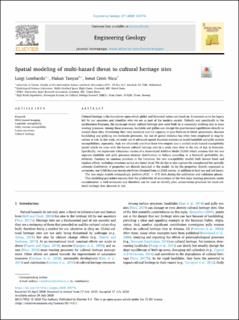| dc.description.abstract | Cultural heritage is the foundation upon which global and historical values are based on. It connects us to the legacy left by our ancestors and identifies who we are as part of the modern society. Globally and specifically in the northeastern Romania, the landscape where cultural heritage sites were built on is constantly evolving due to mass wasting processes. Among these processes, landslide and gullies can disrupt the gravitational equilibrium directly or around these sites, threatening their very existence and our capacity to pass them on to future generations. Because landsliding and gullying are stochastic processes, the use of spatial statistics has often been employed to map locations at risk. In this work, we make use of advanced spatial Bayesian statistics to model landslide and gully erosion susceptibilities, separately. And, we ultimately combine these two outputs into a unified multi-hazard susceptibility model which we cross with the known cultural heritage sites in a study area close to the city of Iaşi, in Romania. Specifically, we implement a Bayesian version of a Generalized Additive Model (GAM) which assumes that the two separate landslide and gully presence/absence distributions to behave according to a Bernoulli probability distribution. Contrary to common practices in the literature, the two susceptibility models both feature fixed and random effects, including covariates acting at a latent level. We do this to also capture the unexplained but spatially coherent distribution of properties not directly included in the model. As for the properties directly expressed as covariates, our GAM features terrain attributes obtained from a LIDAR survey, in addition to land use and soil layers. The two single models outstandingly perform (AUC > 0.9) both during the calibration and validation phases. This modeling procedure ensures that the probability of occurrence of the two mass wasting processes under consideration is well estimated and therefore can be used to reliably plan conservation practices for local cultural heritage sites deemed at risk. | |
